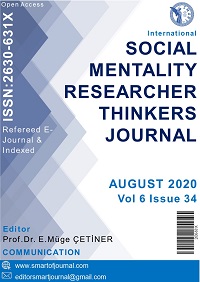JANE AUSTEN'NİN EMMA VE AMY HECKERLING'İN CLUELESS’INDA METİNLERARASILIK BAĞLAMINDA KARAKTER ANALİZİ
Author :
Abstract
Sinema ve klasik eserler arasındaki etkileşime dayanarak, Jane Austen’in Emma ve Amy Heckerling’in Clueless adlı eseri, yirminci yüzyılın merceğinden ilginç bir karakter analizi yapmamızı sağlıyor. Austen romanlarında arazi mülkiyeti, gelir ve sosyal statünün hakim olduğu bir toplumda sevgi ve evlilik temalarını benimsemiştir. 19. yüzyılda yaşayan burjuvazinin ve orta sınıfın evlilik sorunlarından kaynaklanan çatışma ve sorunları ele almıştır. Birçok kadın yazar gibi eleştirildi, eserleri bu sorunlar nedeniyle tanınmadı veya yayınlanmadı. Bu çalışmada ele alınacak olan Emma adlı kitabında, Jane Austen içinde yaşadığı toplumu sosyal gerçekçi yaklaşımıyla yeniden yansıtmıştır ve kadınların, evliliği daha iyi bir yaşam sürmek ya da yalnızlıktan kaçmak için bir çare olarak gördüğü görüşünü eleştirmiştir. Austen, kadın kahramanı Emma aracılığıyla okuyucularına, aşkın, parasal kaygılardan uzak, daha üstün bir yere sahip olması gerektiğini söyler. Öte yandan, Amy Heckerling'in yazdığı ve yönettiği 1995 tarihli bir Amerikan gençlik komedi filmi Clueless, çöpçatanlık yeteneklerine fazlaca güvenmenin sonucunda romantik talihsizliklerden muzdarip olan Emma karakteri gibi Cher'in kendini keşfetme yolculuğunu anlatmaktadır. Bu karşılaştırmalı çalışma, kadınların toplumdaki durumu, evlilik kurumunun kadınlar için sosyal rolü ve sınıf çatışması gibi konuların 21. yüzyılda nasıl algılandığını ve metinlerarasılık bağlamında karakterler üzerinden bu konuların Clueless filmine nasıl yansıtıldığını gösterecektir. Bu yazının amacı, Clueless'ın geleneksel uyarlamasını yeniden yazarken, Heckerling'in metinlerarası yöntemin ana teknikleri olan ironi, pastij ve parodiyi nasıl kullandığını göstermektir. Ayrıca, iki eser arasındaki metinlerarası durum ile yazar ve yönetmenin aynı olaya tarihsel ve kültürel açıdan bakma şekilleri ve bunları farklı kodlarla açıklama biçimleri de incelenecektir.
Keywords
Abstract
Based on the interaction between cinema and classical works, Jane Austen’s Emma and Amy Heckerling’s Clueless enable us to make an intriguing character analysis through the lens of the twentieth century. In her novels, Austen embraced the themes of love and marriage in a society dominated by land ownership, income and social status. She dealt with the conflicts and problems arising from the marriage issues of the bourgeoisie and middle class living in the 19th century. Like many women writers she was criticized, her works were not recognized or published because of these issues. In the book Emma, which will be considered in this study, Jane Austen once again mirrored the society she lived in with her social realistic approach and criticized the view that women regard marriage as a remedy to lead a better life or escape from loneliness. Austen, via her female hero Emma, sends her readers the message that love should be transcendent rather than monetary concerns. On the other hand, a 1995 American coming-of-age teen comedy film both written and directed by Amy Heckerling, Clueless reflects the self-discovery journey of the protagonist, Cher, like Emma, who suffers from the outcomes of her misplaced confidence in her matchmaking abilities in the form of romantic misadventures. This comparative study will demonstrate how the issues, such as the status of women in society, the social role of the marital institution for women and class conflict have been perceived in the 21st century, and how they are reflected in the movie Clueless by focusing on characters in the context of intertextuality. The purpose of this paper is also to demonstrate how Heckerling placed the irony, pastij and parody, the main techniques of the intertextual method, while rewriting the traditional adaptation of Clueless. Furthermore, the intertextual situation between the two works and the way the writer and director look at the same event from historical and cultural perspectives and explain them in different codes will be examined.
